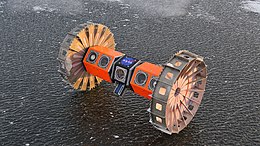 BRUIE prototype | |
| Designer | NASA's Jet Propulsion Laboratory |
|---|---|
| Country of origin | US |
| Operator | NASA |
| Applications | Planetary science, astrobiology |
| Specifications | |
| Spacecraft type | robotic aquatic rover |
| Design life | several months |
| Dimensions | |
| Length | 1 m (3 ft 3 in) |
| Capacity | |
| Payload to {{{to}}} | |
| Production | |
| Status | in development |
BRUIE (Buoyant Rover for Under-Ice Exploration) is an autonomous underwater vehicle prototype by NASA's Jet Propulsion Laboratory. The prototype began underwater testing in 2012 and it is meant to eventually explore the interior of water worlds in the Solar System, such as Europa or Enceladus. [1]
Overview
On Earth, aquatic life is often found at the ice-water interface, so researchers designed the robotic rover to be buoyant and use its two wheels (25 cm (10 in) each) to roll along beneath the ice and look for life or their biosignatures. [2] [3] Scientists can also learn a lot from the topography of the underside of the ice, including how the ice forms. And the ice can act as a trap for gases, either from biological or geological processes. [1]
The first BRUIE prototype began testing in 2012 in an Arctic lake in Alaska, [4] [2] [5] and in Antarctica in 2019. [2] [5] [3] [1] The principal investigator is Andy Klesh at JPL; the co-investigators are Kevin Hand, Dan Berisford, John Leichty and Josh Schoolcraft. [6] Astrobiologist Kevin Hand at JPL is the lead scientist. [5]
Description
The rover resembles a bar 1 m (3 ft 3 in) long, with two large studded wheels at each end. [5] BRUIE features cameras, lights, and eventually it will be equipped with wireless communication to remotely navigate autonomously without a tether. [5] [6] It can also carry some scientific instruments, which would be incorporated later if preliminary testing goes well. [1]
BRUIE uses buoyancy to remain anchored against the ice and resist water currents. The sealed air-filled cylindrical body, along with closed-cell foam inside of cone-shaped wheels, provides buoyancy force to enable roving along the underside of the ice. [7] In can safely power down to save battery, turning on only when it needs to take a measurement, so it could spend months observing the under-ice environment at time intervals. [5] [2]
Challenges
One obstacle facing aquatic vehicles like BRUIE is how to deliver it through the thick ice shell. [1] On Europa, the ice sheet could be up to 30 km (19 mi) thick. One preliminary concept for delivering such vehicles through the ice shell is a nuclear-powered tunneling robot called Cryobot, proposed by German engineers. [8] Heat from nuclear power would melt the ice and the penetrator would propel itself through the hole. Once through, the attached aquatic vehicle could be deployed to explore. [1] The 2025 Europa Clipper orbiter will measure the ice shell thickness of Europa, which will help determine if a vehicle pair like BRUIE and Cryobot are a possible next step. [1]
See also
- Autonomous underwater vehicle – Unmanned underwater vehicle with autonomous guidance system
- Cryobot – Autonomous ice penetrator vehicle
- DEPTHX – Autonomous underwater vehicle for exploring sinkholes in Mexico
- IceMole – Autonomous ice penetrator vehicle
- Radioisotope thermoelectric generator – Electrical generator that uses heat from radioactive decay
References
- ^ a b c d e f g Gough, Evan (22 November 2019). "Aquatic Rover Drives on the Underside of the Ice in Antarctica". Universe Today.
- ^ a b c d McFall-Johnsen, Morgan (23 November 2019). "NASA is testing an alien-hunting rover in Antarctic waters as part of the agency's plans to send robots to ocean moons of Jupiter and Saturn". Business Insider.
- ^ a b Bartels, Meghan (20 November 2018). "NASA's Undersea Robot Crawls Beneath Antarctic Ice in Test for Icy Moons". Space.com.
- ^ Berisford, D. F.; Leichty, J.; Klesh, A.; Hand, K. P. (December 2013). "Remote Under-Ice Roving in Alaska with the Buoyant Rover for Under-Ice Exploration". AGU Fall Meeting Abstracts. 2013. Bibcode: 2013AGUFM.C13C0684B.
- ^ a b c d e f Samuelson, Arielle (18 November 2019). "Aquatic Rover Goes for a Drive Under the Ice". JPL NASA.
- ^ a b Landau, Elizabeth (25 June 2015). "Under-Ice Rover Chills With Fish at Aquatic Exhibit". NASA News.
- ^ Buoyant Rover for Under-Ice Exploration. Berisford, D. F.; Leichty, J. M.; Klesh, A. T.; Matthews, J. B.; Hand, K. P. AGU Fall Meeting Abstracts. December 2012. Bibcode: 2012AGUFM.C13E0655B
- ^ An Architecture for a Nuclear Powered Cryobot to Access the Oceans of Icy Worlds. Thomas Cwik, Wayne Zimmerman, and Miles Smith. Nuclear and Emerging Technologies for Space, American Nuclear Society Topical Meeting. Richland, WA, February 25 – February 28, 2019.
External links
- BRUIE: Buoyant Rover for Under Ice Exploration. Video at NASA (2016)